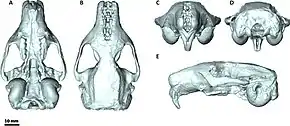Leithia
Leithia is a genus of extinct giant dormice from the Mediterranean islands of Malta and Sicily. It is considered an example of island gigantism. Leithia melitensis is the largest known species of dormouse, living or extinct, being twice the size of any other known species.
| Leithia Temporal range: Pleistocene | |
|---|---|
 | |
| Model of the skull of L. melitensis | |
| Scientific classification | |
| Kingdom: | Animalia |
| Phylum: | Chordata |
| Class: | Mammalia |
| Order: | Rodentia |
| Family: | Gliridae |
| Subfamily: | Leithiinae |
| Genus: | †Leithia Lydekker, 1896 |
| Species | |
| |
Discovery and taxonomy
The species were first named by Andrew Leith Adams in 1863 from remains found in caves in Malta and were assigned to the living genus Myoxus.[1] Leithia was proposed in 1896 by Richard Lydekker as the type genus of the Leithiinae, and was named after the Andrew Leith Adams.[2] It is estimated to have weighed up to 113 g (4.0 oz). In the time before the Mediterranean islands were colonised by humans, dozens of mammal species endemic to the area, some unusually large like Leithia, some unusually small (such as pygmy elephants and hippopotamuses) lived in Malta and Sicily, while another giant dormouse, Hypnomys, lived on Mallorca to the west. In an instance of island gigantism, the dormice were able to grow large in the absence of predators on these islands, which otherwise force rodents to hide in holes or cracks, requiring them to be small.[3] Two species of Leithia, namely L. melitensis (the Maltese giant dormouse) and the smaller L. cartei, lived in Sicily and Malta.[4] The skull of L. melitensis was 10 cm long.[5]
See also
References
- Adams, A. L. (1863), ‘Observations on the Fossiliferous caves of Malta’. Journal of the Royal Society, 4 .2. pp.11–19.
- Wilson, Don E.; Reeder, DeeAnn M., eds. (2005). Mammal Species of the World: A Taxonomic and Geographic Reference, Volume 12. JHU Press. p. 829.
- Davis, Simon (3 January 1985). "Tiny Elephants and Giant Mice". New Scientist: 25–27.
- Petronio, C. (1970). "I Roditori Pleistocenici della Grotta di Spinagallo (Siracusa)" (PDF). Geol. Rom. IX: 149–194. (in Italian)
- Davis, Simon (1987). The Archaeology of Animals. Psychology Press. pp. 120–121.